ACA Dark Current Calibration 2000-Nov-20
On 2000-Nov-20, an ACA dark current calibration was performed (see the SOT shift
report). This consisted of 5 pointings at slightly offset (2 arcmin)
attitudes. At each pointing, two full frame readouts were performed, one with
a 5 second integration and one with 10 seconds. This gave a total of 10 full
frame readouts. For a given integration time, the 5 images were median
filtered on a pixel-by-pixel basis to remove star images. Then the 5-second
median-filtered image was subtracted from the 10-second median-filtered image
to remove dark current accumulation during the readout period. This is
important as it takes approximately 8 seconds to read out a CCD quadrant.
Finally, the dark current image was converted from counts/integration to
electrons per second (e-/s).
Comparison to calibration during OAC (SSD closed)
On 1999-Aug-11, during Orbital Activation and Checkout (OAC), a dark current
calibration was performed. At this time, the sunshade door was closed, so
the true dark current was measured. The data were reduced by Rob Cameron.
In the following sections, we compare the 2000-Nov-20 data to the OAC data.
Basic statistics
| |
OAC (1999-Aug-11) |
2000-Nov-20 |
| Mean (e-/s) |
11.9 |
22.2 |
| Median (e-/s) |
10.4 |
12.0 |
| N > 100 e-/s |
3495 |
34346 |
The statistics above show that there has been little change in the median
dark current between OAC and 2000-November, but that there has been about
a factor of 10 increase in the number of "warm" pixels. This increase
in warm pixels is responsible for a factor of 2 increase in the mean dark
current.
Differential histogram
The plot below shows the differential distribution of dark current values,
in number of pixels per 1.0 e-/sec bin. The factor of 10 increase
in warm pixels is evident in the tail above ~30 e-/sec.
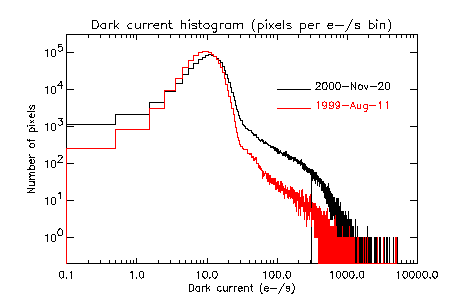
The graph below shows the same data, plotted on a linear scale near
zero. There is a substantial non-gaussian tail of negative dark current
values. It is not clear if this is real or a processing artifact.
The OAC dark calibration shows only a gaussian tail consistent with electronic
read-out noise.
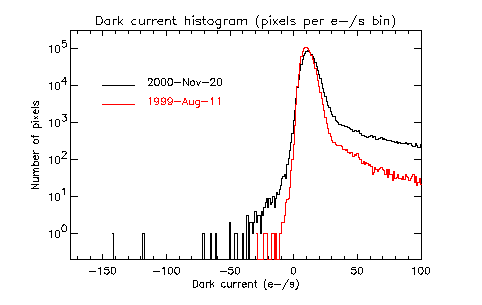
Cumulative histogram
Below, the cumulative histogram is shown, indicating the fraction of pixels
with dark current greater than a given value. About 7% of pixels
are in the non-gaussian tail above 30 e-/sec, and about 3% are considered
"warm", with a dark current greater than 100 e-/sec. "Warm" pixels
will noticably affect the ground aspect solution if not subtracted out.
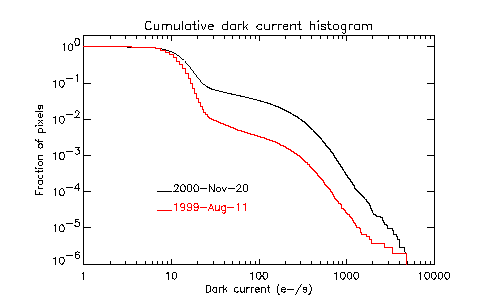
Pixel by pixel comparison
The figure below shows a scatter plot of the dark current value in each pixel
measured on 1999-Aug-11 ("old") and the value measured on 2000-Nov-20 ("new).
The red line shows "old" = "new", and only pixels with "old" dark current greater
than 30 e-/s are shown. The population of pixels which became warm
after the old measurement is clearly visible on the left side of the plot.
Pixels which were warm during OAC have, on average, the same warm value now.
However, there is substantial scatter which is inconsistent with electronics
read noise and/or counting noise. A significant fraction of warm pixels
show a decrease in dark current by a factor of 2 or more. The scatter
amplitude is roughly proportional to dark current value (remembering that the
plot is a log-log plot).
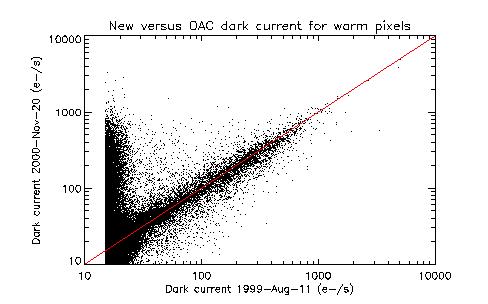
The dependence of scatter in the new versus old dark current values is
illustrated below, where we show a series of histograms of the distribution of
the ratio new/old (as for above, comparing on a pixel-by-pixel basis). The
four histograms are calculated using logarithmically spaced slices based on the
old dark current value. The plots show that the relative scatter is stable or
slightly increasing with increasing dark current. For pure counting noise, we
would expect a 1/sqrt(N) decrease in these plots. This again implies that
warm pixel values cannot easily be calibrated for the purpose of subtracting
them in ground aspect pipeline processing.
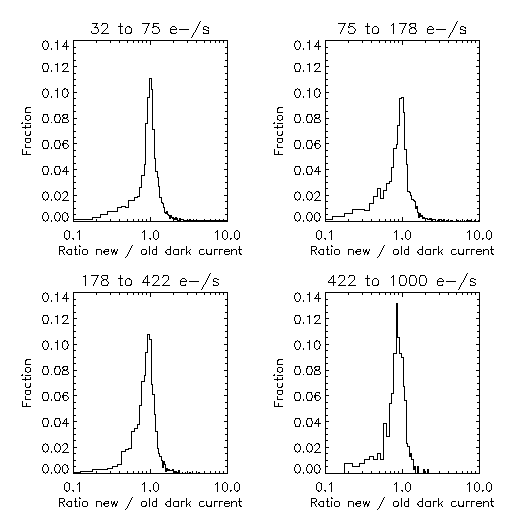
Comparison with "warm pixels" detected by aspect pipeline
The graph below shows a scatter plot of dark current, measured by
two different methods. On the X-axis is the value from the 2000-Nov-20 ACA
calibration. On the Y-axis is the dark current value found by the aspect
pipeline tool aca_find_hot, which searches for warm pixels at the 6x6 image
edge. In general, there is a good correlation between the two measurements.
The red line indicates y=x.
However, it is interesting to note the population of warm pixels found by
aca_find_hot (shown in blue) which have low dark current in the ACA cal dump.
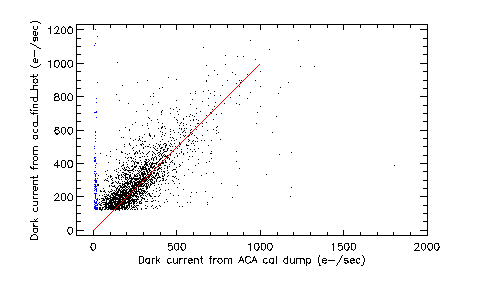
A slightly different test is to compare the aca_find_hot values
to the ACA cal values for a small set of observations taken near 2000-Nov-20.
The scatter plot below shows this comparison.
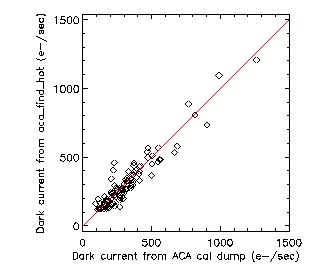
It is not clear from these plots whether the aca_find_hot values are
incorrect, or if the dark current of warm pixels varies with time.
Both of these are true to a certain extent:
-
In the 2000-Nov-20 ACA cal dump, about 10% of warm pixels appear to be
flickering. This is defined as having at least one of the five readouts more
than 50 e-/sec less than the median.
-
In one test run of the aspect pipeline, using the 2000-Nov-20 dark current map
actually degraded the quality of the aspect solution. This is because several
warm pixels were incorrectly subtracted, leaving significant residuals that
produced systematic centroiding offsets.
Time history of warm pixel count
Beginning with CXCDS software release R4CU5UPD7.1, the aspect pipeline performs
"on-the-fly" detection of warm pixels. This is done with the tool
aca_find_hot, which searches for warm pixels at the 6x6 image edge.
Warm pixels detected this way are inserted into the local dark current map
stored in the ACACAL aspect L1 product.
The plot below shows the average number of warm pixels detected per observation
as a function of time (day of mission). This is based on analysis of 516
observations. The data have been grouped in 20 day bins, with the error bars
based on Poisson counting statistics for the number of warm pixels. The large
gap from day ~250 to 350 is because those observations have not yet been
reprocessed, and the original processing was before R4CU5UPD7.1.
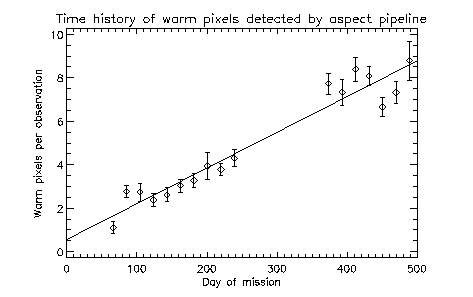
The increase is basically linear with time (as shown by the best-fit line),
although there are interesting deviations around day 80 and day 450. These may
be artifacts of the detection method. This line is consistent with the
factor of 10 increase in warm pixels since OAC (day ~20 of mission).
Implications
The current rate of increase of warm pixels is about 23000 per year, or 2.2% of
the focal plane per year. This is probably an upper limit to the rate, since
we are currently at the Solar max. At this rate, there should no problems with
ground aspect determination nor on-board star acquisition in the next 2-3
years. However, in the 5-10 year time frame, warm pixels could make up 10-20%
of the CCD focal plane. With sufficient operational effort, dark current maps
will allow subtraction of warm pixels and hence high-quality ground aspect
solutions. A bigger concern is on-board acquisition of faint stars in the
presence of many warm pixels. The magnitude of this potential problem
is difficult to determine, since it depends on details of the ACA
search/acquisition algorithm. A simulation of this algorithm is likely
the best way to address this issue.
Tom Aldcroft
Last modified:
12/15/00








